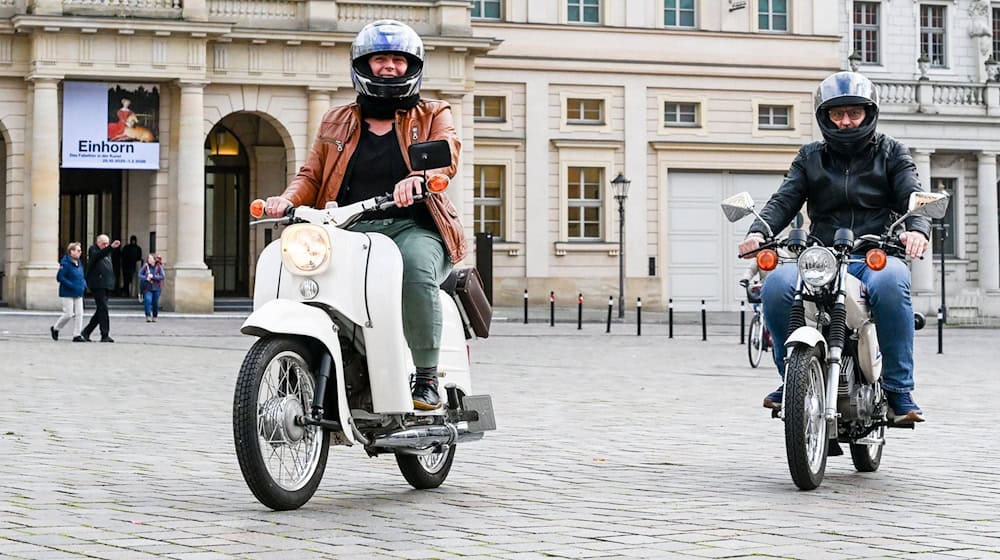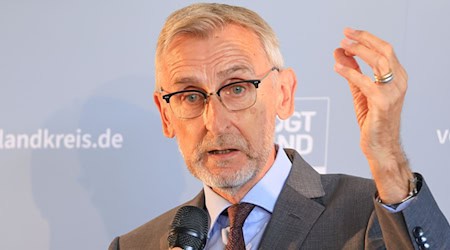Riding a moped in November is not always a pleasure. But the two SPD MPs Nadine Graßmel and Wolfgang Roick were not interested in riding pleasure when they drove up to the Potsdam state parliament on their Simsons this week. They want protection and recognition for the millions of mopeds built in the GDR era.
Thuringia already had it on the table in September, when Minister President Mario Voigt (CDU) said: "Simson is Thuringia, Simson is freedom on two wheels, Simson is a way of life." The state parliament in Saxony dealt with the cult object in October, the cabinet in Mecklenburg-Western Pomerania at the beginning of November. In Saxony-Anhalt, the CDU submitted a "groundbreaking motion" on the subject a few days ago.
Speed 60 is the target
In concrete terms, it's roughly the same everywhere: Simsons are officially allowed to drive at 60 km/h due to a special clause in the 1990 Unification Treaty, provided they were on German roads before the end of February 1992. The East German states now also want the special regulation for Simsons that were exported to other - mostly socialist - countries during the GDR era and are now being brought back to Germany, i.e. re-imported. Sounds special? Not for many East Germans.
"The Simson is more than just a moped," says Elisabeth Kaiser (SPD), the Federal Government Commissioner for Eastern Germany. "For young people in particular, it is a promise of mobility and freedom in rural areas. It's just as important today as it was in the past." Schwalbe, Star or S51 - the machines were robust and easy to repair and they have been around since the 1960s to this day. "No wonder the 'Simme' is cult," says the SPD politician.
"Need identity anchors"
For many East Germans, the Simson is an "identity anchor", says Sören Marotz, Exhibition Director of the DDR Museum in Berlin. "It's human nature that we need identity anchors."
Marotz himself bought a Simson S51 as a teenager in East Berlin in 1988. You had to wait ten years or more for cars in the GDR, and mopeds were readily available new or used from around 1,000 GDR marks, the historian recalls. Around six million of all Simson models were built over the decades. Simsons were part of everyday life. Young people rode them in pairs across the countryside, policemen rode them, pastors rode them, the parish nurse Agnes rode the Schwalbe. "It was a practical utility moped," says Marotz.
Cult came later
"The whole cult that is being created now, the political debates, these are, so to speak, inventions that can be understood," adds his historian colleague Stefan Wolle. It is a phenomenon that many things that were reviled and ridiculed in the GDR are held in high esteem in retrospect. Many people have said: "We don't let ourselves be looked down on by Westerners, who of course always had the fancier cars and the fancier motorcycles and everything fancier and more money, but we identify with what we have." It was similar with the Trabbi as it was with the Simson. "It's a sub-phenomenon of the cult of the East," says Wolle.
This, in turn, seems to fit the times 35 years after reunification - a time of uncertainty and misunderstandings and demarcation between East and West. And it seems to be a fitting topic for the AfD. Thuringia's state party leader Björn Höcke, a native of Westphalia, spoke enthusiastically about Simson excursions with young supporters during the 2024 election campaign. The 53-year-old likes to advertise his "Simson tours" with photos in which he is not wearing a helmet on his moped.
The AfD put forward
Many of the state parliament debates in the east were initially based on proposals from the AfD, which also campaigned for the Simson to be protected as an "intangible cultural heritage". The Simson stands for "freedom, independence and individuality", according to an AfD motion in Brandenburg. The other parties felt compelled to reclaim the issue from the far-right party.
It annoys her "when the Simson is appropriated by West German populists and extremists, who then use it to make a bold statement, but are otherwise not at all interested in the special experiences of East Germans," says Kaiser, the East German Commissioner. "For me, the Simson doesn't stand for Ostalgie, but for the fact that East German engineering is still enriching the entire country, now even as an e-swallow with an electric motor."
West Germans have "saved" the Simson
Stefan Drönner from Simson-Freunde Kassel, a group of currently seven passionate mechanics, also distances himself from the AfD or any political goals. "We're all about the mopeds," says the 57-year-old West German.
He bought his first Simson shortly after the fall of the Berlin Wall because the spare parts for his Vespa were too expensive. It was a time when many in the East wanted to get rid of their Simson. From 1989 to the 2000s, "the things were given away for a crate of beer at the beginning and then maybe for 150 euros," says Drönner.
And he is convinced: "If it hadn't been for us West Germans, there wouldn't be so many Simsons on the streets. We actually saved it. I say that to every East German. I'm proud of that too."
Copyright 2025, dpa (www.dpa.de). All rights reserved










